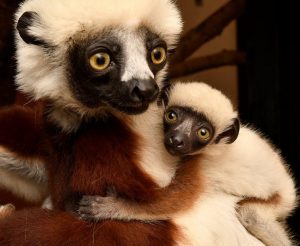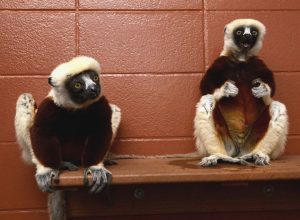
Rupi with Magdalena. Coquerel’s sifakas are endangered in the wild.
The Duke Lemur Center is delighted to announce the birth of Magdalena, niece of the famous Zoboomafoo!
Magdalena was born May 14, 2017 to parents Rupillia and Luther. Rupi was born in 1999 and is little sister to Jovian (Zoboomafoo), who was five years her senior. Both she and Luther, how was born in 2003 at the St. Louis Zoo, are extremely important to the Coquerel’s sifaka breeding program because they are genetically underrepresented.
Last year, the Coquerel’s sifaka Species Survival Plan (SSP) decided that it was important for Rupi to breed a few more times, and Luther, leaping at the opportunity, submitted his genetic resume to the SSP. A few short months later, Luther was on a jet bound for North Carolina, and he and Rupi were introduced in early November. The pair quickly became inseparable, and Rupi responded to Luther’s charms by experiencing a very much out of season reproductive cycle in December (a month usually marking the beginning of sifaka birth season, not mating season), which accounted for Magdalena’s unusual May birth.
How did Magdalena get her name?
Each species at the DLC has a naming theme. Duke’s sifakas are named for Roman nobility, and Magdalena – who shares her name with Empress Eleonora Magdalena – is no exception.
Not only this, but the name Magdalena is doubly appropriate: Magdalena Luther was the daughter of Protestant reformer Martin Luther, a theologian well known for his affection for his children. The DLC’s Luther, in addition to sharing his name with the famous theologian, is also an attentive and tolerant dad.
How involved are male sifakas in caring for their offspring?
Male sifakas “exhibit variable levels of caregiving behavior, ranging from benign neglect to appreciable attentiveness” and some males hold, groom, and play with infants more often than others (Bastian and Brockman 2007). Unlike some male sifakas, Luther has proved both attentive and tolerant of the infant’s clinging and climbing. On May 27, for example, their technician Steve writes: “About mid-morning, Luther had the baby wrapped tightly around his belly. About 25-30 minutes later, the baby was back on Rupi. Later this afternoon, Luther had the infant again, and the infant was active and exploring Luther’s head, rear end, and legs. Rupi saw that the kid was active and expertly swapped the kid back to her own belly.”
As indicated in Steve’s notes, sifakas are female-dominant, and a mother sifaka controls the sire’s access to the infant. In fact, for the first week or two of an infant’s life, the new mother often separates herself from her family group, including her infant’s sire. Infant survival rates are significantly higher when mother and baby live apart for a few days and then gradually rejoin the group when the infant is less vulnerable. At the DLC, wire fencing between the mother’s and sire’s enclosures allow the mother and infant to be separate and safe, while also maintaining visual and olfactory contact with the rest of the family.
When Rupi and Magdalena were reintroduced to Luther, the pair came together with singing and grooming. Luther even managed to get a few grooming licks on the infant, though Rupi kept tight control on his access to Magdalena (and cuffed him when he went too far!). Their first introduction lasted 50 minutes; their second lasted five hours with more singing and grooming right at the start. Their technician, Steve, noted that the pair spent more time together, that both were relaxed, and that Luther was able to groom the infant quite frequently but Rupi still kept control! The trio is now living together 24/7, with Rupi taking Magdalena back from Luther if she grows concerned that the infant has been on Luther (and away from nursing) for too long.

Magdalena nursing.

Rupi with Magdalena.

Rupi and Luther just three days after their introduction. The normally highly dominant Rupi took an intense shine to Luther in a very short time…! In fact, she liked Luther so much that she allowed him to sit beside her on the shelf and share her peanuts, a favorite sifaka treat!
Note: An early version of this article identified Magdalena as Zoboomafoo’s granddaughter. She is, in fact, his niece.
Did you know…
It costs $7,400 per year to feed, house, and care for each lemur at the Duke Lemur Center. Please consider making a donation or symbolically adopting a lemur today. Your gift at any level makes a difference!

